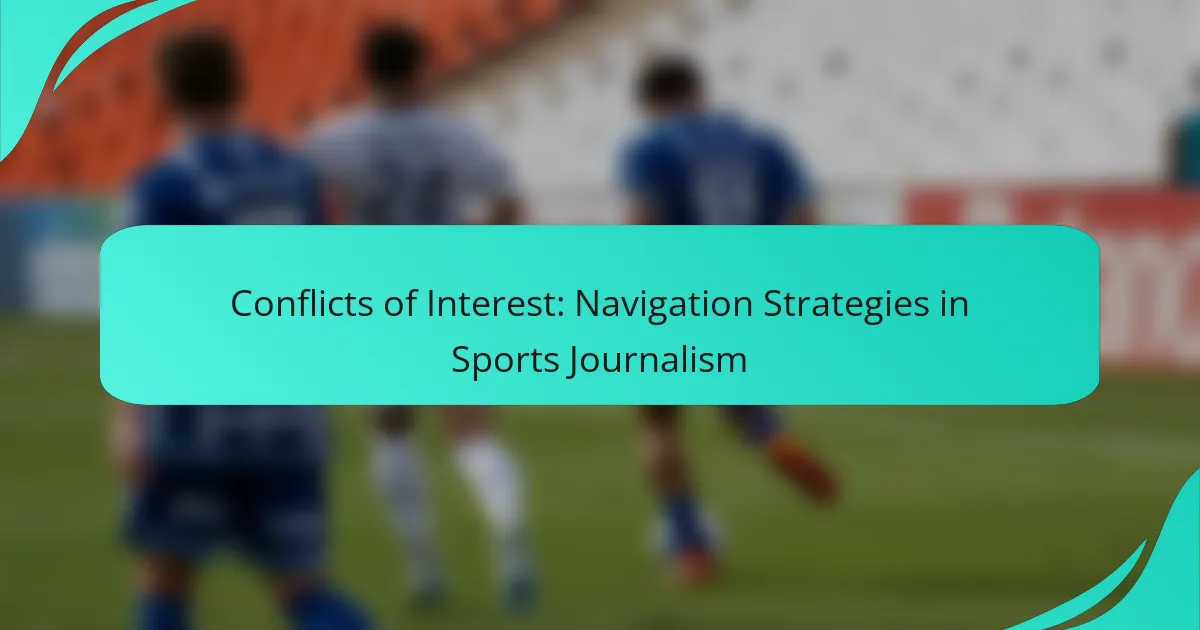Conflicts of interest in sports journalism pose significant challenges to maintaining integrity and unbiased reporting. Effective navigation strategies, such as transparency and clear editorial guidelines, are essential for fostering trust with audiences. By critically examining personal and professional relationships, journalists can identify potential conflicts and uphold ethical standards in their work.
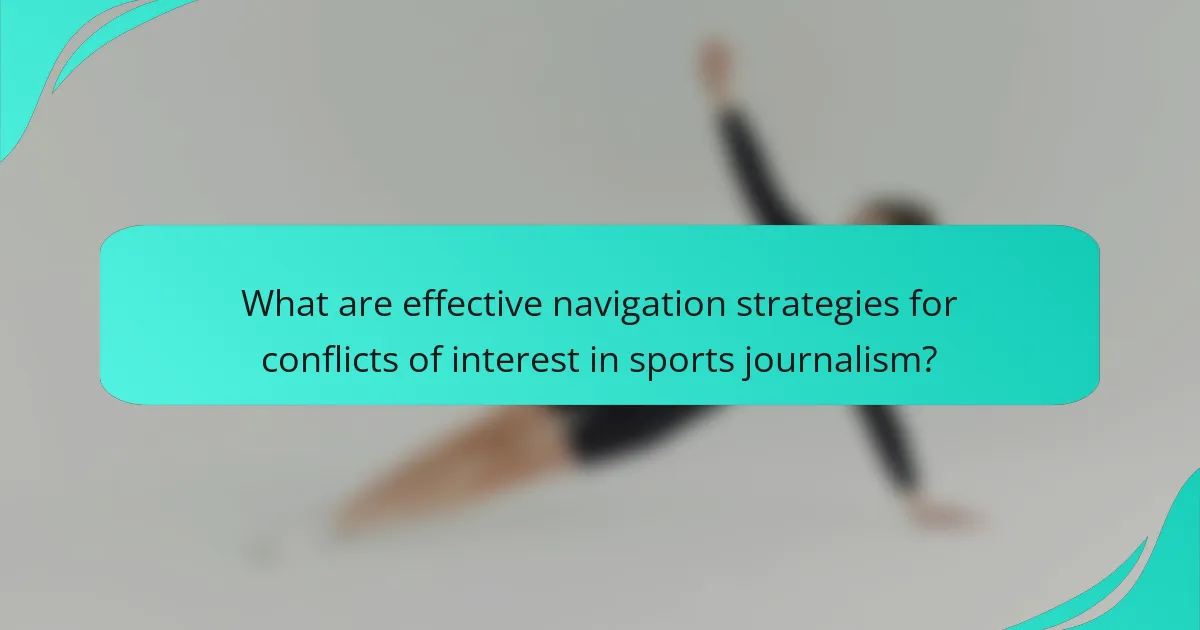
What are effective navigation strategies for conflicts of interest in sports journalism?
Effective navigation strategies for conflicts of interest in sports journalism include maintaining transparency, establishing clear editorial guidelines, utilizing conflict of interest disclosures, and implementing independent oversight. These strategies help ensure that reporting remains fair and unbiased, fostering trust among audiences.
Transparency in reporting
Transparency in reporting involves openly sharing any potential conflicts of interest with the audience. Journalists should disclose relationships with teams, athletes, or sponsors that could influence their reporting. This practice builds credibility and allows readers to assess the reliability of the information presented.
For instance, a journalist covering a local sports team who has a family member working for the organization should clearly state this connection in their articles. This openness helps mitigate skepticism and promotes ethical standards in sports journalism.
Establishing editorial guidelines
Establishing editorial guidelines is crucial for maintaining integrity in sports journalism. These guidelines should outline acceptable practices regarding conflicts of interest, including how to handle situations where personal interests may interfere with professional responsibilities. Clear policies help journalists navigate complex scenarios effectively.
For example, a guideline might stipulate that journalists must recuse themselves from reporting on events where they have a personal stake, such as covering a game involving a team they support. This creates a framework for ethical decision-making.
Utilizing conflict of interest disclosures
Utilizing conflict of interest disclosures involves formally documenting and communicating any potential conflicts that may arise. This can include a standard disclosure form that journalists complete, detailing any affiliations that could affect their reporting. Such disclosures should be easily accessible to the audience.
Many media organizations adopt policies requiring disclosures to be included in articles or broadcasts. For instance, a sports news outlet might include a brief note at the end of an article stating any relevant conflicts, ensuring transparency and accountability.
Implementing independent oversight
Implementing independent oversight can further enhance the integrity of sports journalism. This may involve establishing an editorial board or ethics committee that reviews content for potential conflicts of interest before publication. Independent oversight helps ensure adherence to ethical standards and provides an additional layer of accountability.
For example, a sports media organization might have an ethics committee that evaluates stories involving sponsorship deals or partnerships with teams, ensuring that coverage remains impartial. This proactive approach can help prevent conflicts from undermining journalistic integrity.

How can sports journalists identify conflicts of interest?
Sports journalists can identify conflicts of interest by critically examining their personal, financial, and professional relationships that may influence their reporting. Recognizing these conflicts is essential to maintain journalistic integrity and ensure unbiased coverage.
Recognizing personal affiliations
Personal affiliations can significantly impact a journalist’s objectivity. Journalists should assess their connections to teams, athletes, or organizations they cover, including friendships or family ties that may create bias. For instance, if a journalist has a close relationship with a player, it may affect their ability to report fairly on that player’s performance or conduct.
To navigate this, journalists should disclose any personal relationships to their editors and consider recusing themselves from covering stories involving those individuals. Transparency is key to maintaining credibility.
Assessing financial relationships
Financial relationships, such as sponsorships or investments, can lead to conflicts of interest in sports journalism. Journalists must evaluate any financial ties they have with teams, leagues, or athletes that could compromise their impartiality. For example, owning stock in a sports franchise might influence a journalist’s reporting on that team.
To mitigate these risks, journalists should avoid accepting gifts or payments from sources they cover and disclose any financial interests related to their reporting. Regularly reviewing financial disclosures can help maintain ethical standards.
Evaluating professional connections
Professional connections, such as previous employment or collaborations with sports organizations, can create potential conflicts of interest. Journalists should consider whether their past experiences may bias their current reporting. For instance, a journalist who previously worked for a sports team may struggle to report critically on that team’s management decisions.
To address this, journalists should disclose past affiliations to their audience and editors. Establishing clear boundaries and guidelines for reporting on former employers can help maintain objectivity and trustworthiness in their work.

What role do ethics play in sports journalism?
Ethics are fundamental in sports journalism as they guide reporters in maintaining integrity, fairness, and accountability. Adhering to ethical standards helps journalists navigate conflicts of interest and ensures that their reporting is trustworthy and unbiased.
Guiding principles for ethical reporting
Key principles for ethical reporting include accuracy, transparency, and impartiality. Journalists should verify facts before publication, disclose any potential conflicts of interest, and strive to present multiple perspectives on a story. For instance, if a reporter has a personal relationship with an athlete, they must disclose this to maintain transparency.
Additionally, respecting the privacy of individuals involved in sports is crucial. Journalists should avoid sensationalism and focus on reporting that serves the public interest while being respectful of the athletes’ dignity.
Impact of ethics on credibility
The credibility of sports journalism heavily relies on ethical practices. When journalists adhere to ethical standards, they build trust with their audience, which is essential for long-term success. A single ethical breach can lead to a significant loss of credibility, affecting not only the individual journalist but also their publication.
Moreover, ethical reporting can enhance the overall quality of sports journalism. By prioritizing integrity, journalists can foster a more informed public, which ultimately contributes to a healthier sports culture. For example, accurate reporting on athlete health and safety issues can lead to better policies and practices within sports organizations.
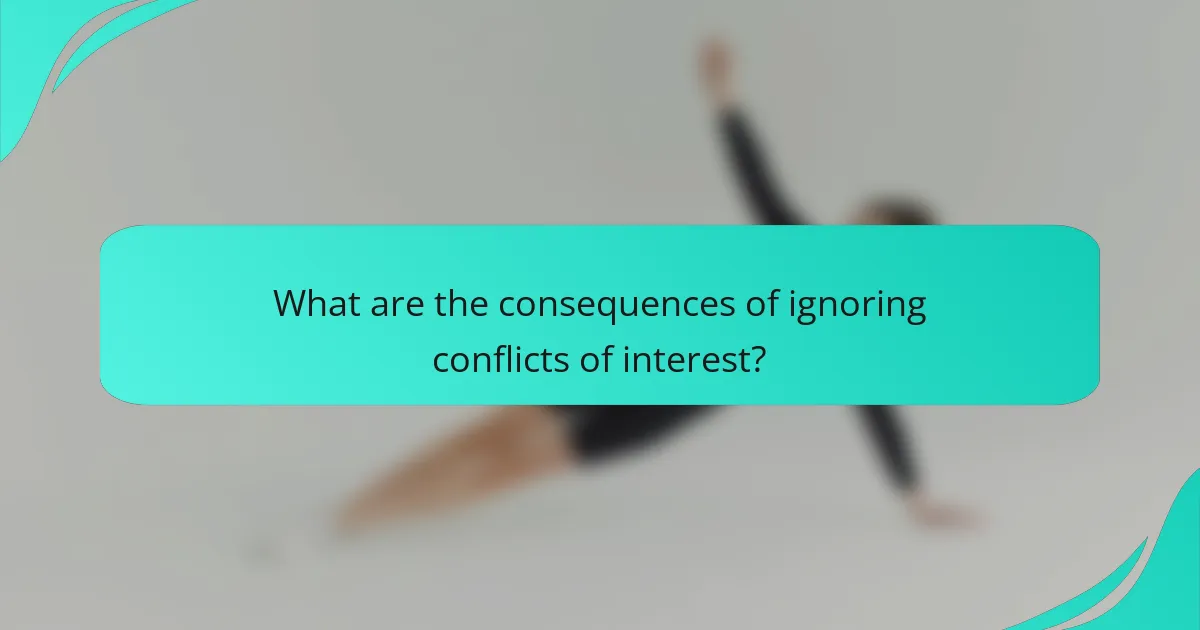
What are the consequences of ignoring conflicts of interest?
Ignoring conflicts of interest in sports journalism can lead to significant damage, including a loss of credibility and potential legal issues. When journalists fail to disclose personal biases or financial interests, they risk undermining the integrity of their reporting and the trust of their audience.
Loss of audience trust
When conflicts of interest are not addressed, audiences may begin to question the reliability of the information presented. Trust is foundational in journalism; once lost, it can take considerable time and effort to rebuild. For instance, if a sports journalist promotes a product without disclosing a financial stake, readers may feel misled and disengage from future content.
To maintain trust, journalists should always disclose any potential conflicts. This transparency helps audiences understand the context of the reporting and reinforces the journalist’s commitment to integrity.
Legal repercussions for media outlets
Media outlets that ignore conflicts of interest can face legal challenges, including lawsuits and regulatory scrutiny. If a journalist’s undisclosed interests lead to biased reporting, it may result in claims of defamation or breach of fiduciary duty. Such legal issues can be costly and damage the outlet’s reputation.
To mitigate risks, media organizations should implement strict guidelines for conflict disclosure. Regular training for journalists on ethical standards can help ensure compliance and protect against potential legal pitfalls.
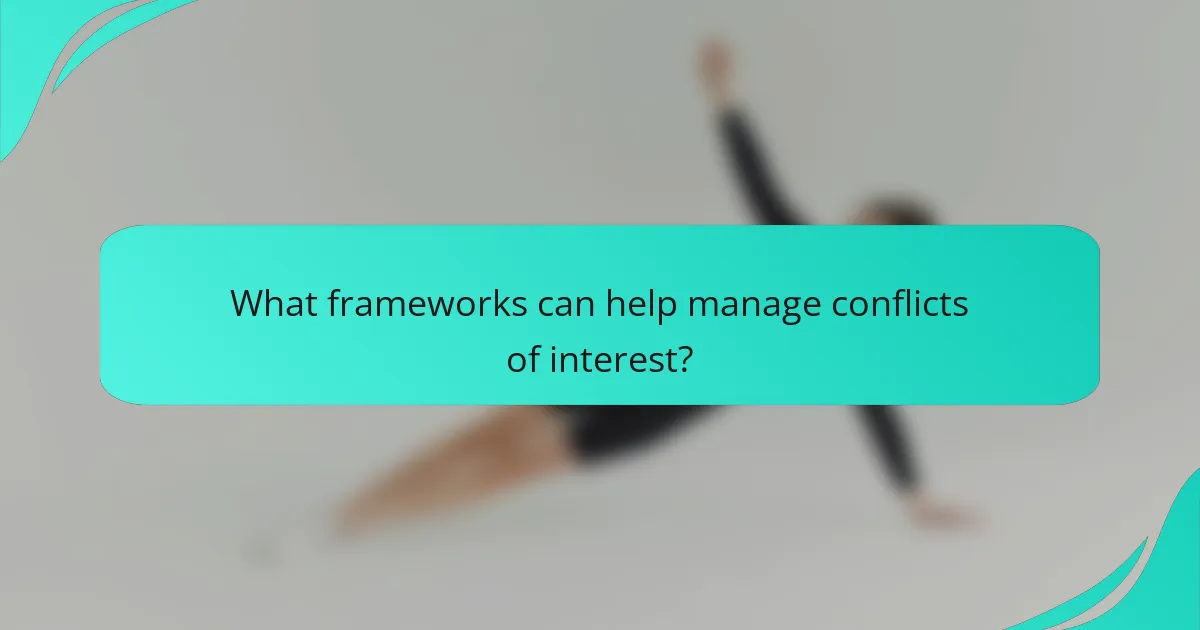
What frameworks can help manage conflicts of interest?
Frameworks for managing conflicts of interest in sports journalism include clear policies and comprehensive training programs. These structures help ensure transparency and ethical reporting, allowing journalists to navigate potential biases effectively.
Developing a conflict of interest policy
A conflict of interest policy outlines the expectations and responsibilities of journalists regarding potential biases. This policy should define what constitutes a conflict and provide guidelines for disclosure and management. For example, a journalist covering a local team should disclose any personal relationships with players or coaches to maintain credibility.
Key elements of a robust policy include a clear definition of conflicts, procedures for reporting them, and consequences for non-compliance. Regular reviews and updates to the policy can help adapt to changing circumstances in the sports industry.
Training programs for journalists
Training programs are essential for equipping journalists with the skills to recognize and manage conflicts of interest. These programs should cover ethical standards, case studies, and practical scenarios to help journalists understand the implications of their reporting choices. Workshops and seminars can be effective formats for delivering this training.
Additionally, ongoing education is crucial as the landscape of sports journalism evolves. Encouraging participation in industry conferences and online courses can help journalists stay informed about best practices and emerging issues related to conflicts of interest.
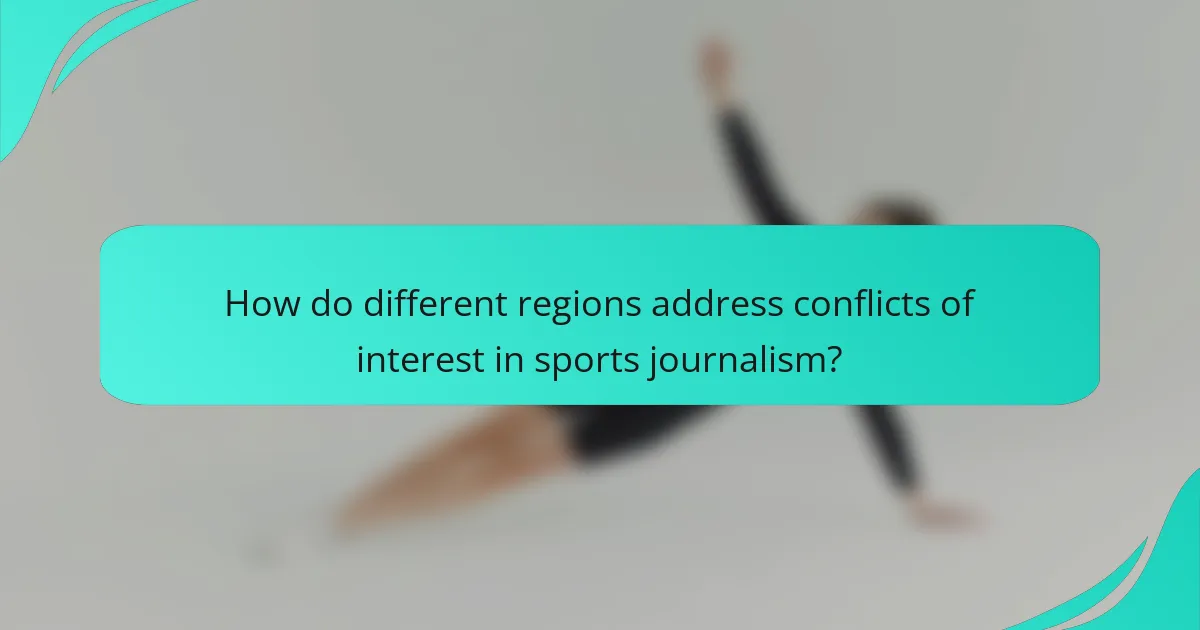
How do different regions address conflicts of interest in sports journalism?
Regions tackle conflicts of interest in sports journalism through various regulatory frameworks and ethical guidelines. These measures aim to ensure transparency, maintain journalistic integrity, and protect the interests of the audience.
Regulatory frameworks in the United States
In the United States, conflicts of interest in sports journalism are primarily addressed through self-regulation by media organizations and adherence to ethical codes set by professional bodies. The Society of Professional Journalists (SPJ) emphasizes the importance of avoiding conflicts that could compromise journalistic integrity.
Many sports journalists are encouraged to disclose any personal affiliations or financial interests that may influence their reporting. For instance, a journalist who has a stake in a sports team should clearly state this relationship when covering related news.
Comparative analysis with European standards
European standards for addressing conflicts of interest in sports journalism often involve stricter regulatory oversight compared to the U.S. In many European countries, media organizations are required to adhere to specific ethical guidelines established by national regulatory bodies.
For example, the UK has the Editors’ Code of Practice, which mandates that journalists must avoid conflicts of interest and disclose any relevant personal connections. This contrasts with the more decentralized approach in the U.S., where individual organizations set their own standards.

What are emerging trends in managing conflicts of interest?
Emerging trends in managing conflicts of interest in sports journalism focus on enhancing transparency and accountability. Journalists and organizations are increasingly adopting strategies that minimize bias and ensure fair reporting.
Increased use of technology for transparency
The integration of technology in sports journalism is a key trend for managing conflicts of interest. Tools such as blockchain can provide immutable records of transactions and sponsorships, allowing journalists to verify the integrity of their sources and affiliations.
Additionally, data analytics platforms help identify patterns of bias in reporting. By analyzing articles and their sources, organizations can pinpoint potential conflicts and take corrective actions. For instance, a sports news outlet might use software to track the frequency of coverage given to sponsors versus non-sponsors.
To effectively implement these technologies, journalists should prioritize training on digital tools and data literacy. This not only enhances their reporting capabilities but also fosters a culture of transparency within their organizations.
